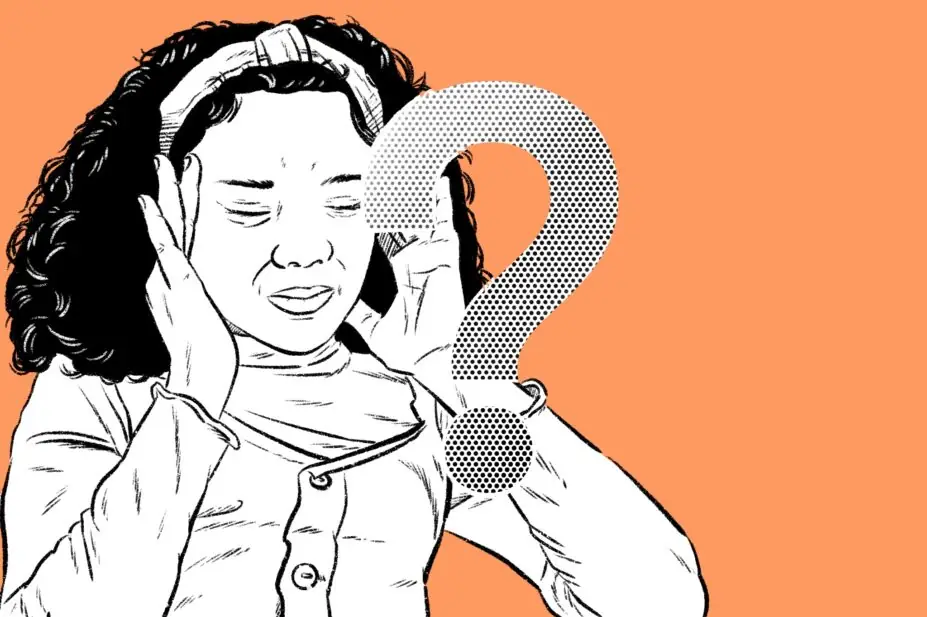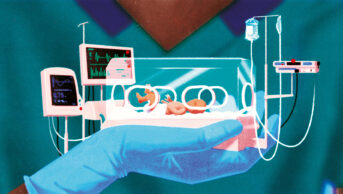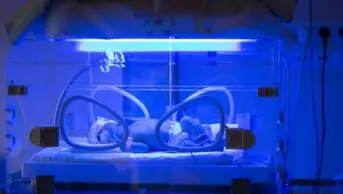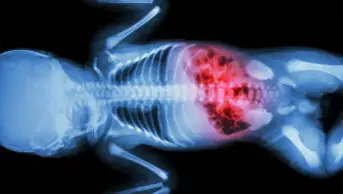
Wes Mountain / The Pharmaceutical Journal
This case example explores how the risk and benefits of off-label sumatriptan can be considered to manage migraines in a ten-year-old girl.
A list of the skills, mapped to the Royal Pharmaceutical Society’s ‘Competency framework for all prescribers’, required to manage such situations can be found at the end of this article.

Case presentation
A ten-year-old girl is being reviewed by the pharmacist on the paediatric inpatient ward. She has been admitted with persistent migraines.
Her parents explain that she has been experiencing frequent and severe headaches for several months, often accompanied by nausea, sensitivity to light and sound, and difficulty concentrating.
The patient was advised by her GP to keep a headache diary, in which she records the frequency, duration and severity of headaches, any triggers she feels may have caused the headache and how the headache has responded to any interventions (for example, over-the-counter [OTC] medications, such as paracetamol and ibuprofen)1.
Despite implementing lifestyle modifications — such as ensuring she has adequate sleep, regular meals and exercise, and using OTC medications — the patient’s migraines continue to interfere with her daily activities and quality of life. She has missed several days of school and has been less able to meet her friends socially.
The pharmacist takes a thorough assessment of the patient’s medical history, including the frequency, duration and intensity of her migraines, as well as any potential triggers or associated symptoms. Her parents are concerned about her ongoing discomfort and wish to explore additional treatment options to alleviate her symptoms and improve her overall wellbeing.

The dilemma
There are several management strategies that can be considered, including waiting to see if the patient’s migraines naturally decrease in frequency or severity as she gets older, this also avoids potential side effects or complications from medications. However, persistent symptoms are likely to affect the patient’s quality of life and school performance and opportunities for early intervention and symptom relief may be missed.
National Institute for Health and Care Excellence (NICE) guidance on headaches in people aged over 12 years recommends treating migraine symptoms with an oral triptan and an NSAID, or an oral triptan and paracetamol2. Patient preference can be considered and a nasal triptan may be preferred for young people aged 12–17 years2.
Oral triptans are licensed for use in people aged over 18 years and nasal triptans are licensed for children aged 12 years and over; however, studies in children (age range 8.2–14.7 years, average age 12.9 years) show triptans to be an effective treatment for migraines3.
This presented a dilemma where the patient’s age necessitated considering off-label or unlicensed medications owing to the lack of strong evidence-based options or dedicated clinical guidance for this age group. Starting an off-label medication could be an effective treatment option and improve the patient’s quality of life and school attendance; however, there are additional considerations when prescribing an off-label medicine.
The primary concern is the lack of robust clinical data supporting the safety and efficacy of these medications in younger children. This makes it difficult to predict both the effectiveness and potential side effects, which could differ significantly from those observed in older children and adults. The use of off-label medications has been associated with an increased risk of medication errors and adverse drug reactions, partly owing to the lack of clear dosing guidelines and the possibility of unforeseen side effects4.
Prescribing these medications can be challenging, especially during transitions between different healthcare settings. Clear communication and agreement between primary care and specialist services are crucial to ensure continuity and safety in the patient’s treatment plan5.
The pharmacist considered the full range of potential options and made an appraisal of their respective advantages and disadvantages. A selection can be seen in Table 12,6–21.

Initial plan
In the decision-making process, it was crucial to consider the benefits and risks of each treatment option, particularly considering the patient’s young age and the potential for side effects, especially in the context of the limited evidence for paediatric-specific medications. The choice of therapy was influenced by clinical guidelines, evidence from paediatric migraine management2,3, and the specific characteristics of the patient’s condition, including the frequency and severity of her migraines and her response to previous treatments.
The patient expressed preference for nasal sumatriptan as it offers a quicker onset of relief compared with oral medications and can be easier to administer during an acute migraine, especially if nausea or vomiting are present. Given that the patient was ten years old at the time of deciding to start the medication, it was important to ensure that she and her family were fully informed that this use of nasal sumatriptan was off-label.
Box: Discussing use of off-label medicines with patients and families
- When prescribing off-label medicines, you should explain that this means the medication is being used in a way not specifically approved by regulatory authorities, such as for a different condition or age group.
- Clearly outline the reasons for choosing this medication, including any supporting evidence or clinical judgement. The potential risks and benefits should be discussed, noting that the medication may not have been extensively studied for this use.
- Patients and their families should be informed of what monitoring needs to take place. It is also important to ensure they understand and consent to the off-label use, and provide information about alternative treatments so that they are able to make an informed choice.
- The Joint Standing Committee on Medicines (a committee of the Royal College of Paediatrics and Child Health and the Neonatal and Paediatric Pharmacy Group) working in partnership with the WellChild charity has produced leaflets on medicines, including one focusing on unlicensed medicines, which explains why it may be necessary to prescribe unlicensed medicines or to use licensed medicines for unlicensed applications. This leaflet should be made widely available to all, especially parents/carers, hospitals and pharmacies via the RCPCH website, where a selection of leaflets are freely available to download22–25.
The pharmacist prescribed nasal sumatriptan at the lowest dose recommended: initially 10mg for one dose, followed by 10–20mg after at least two hours if required, to be taken only if migraine recurs (patients not responding to initial dose should not take second dose for same attack); for a maximum of 40mg per day.

Appropriate monitoring
The pharmacist asks the patient to come back to see her in clinic after four to six weeks to monitor her response to the medication. She also contacts the school nurse and teachers to monitor her response to the sumatriptan, as well as explaining to them how to use the nasal spray.

Additional actions agreed
The patient expressed feeling somewhat self-conscious about using nasal sumatriptan at school in front of her friends. This is a common concern among children and adolescents, who may worry about appearing different or attracting attention. To address this, the pharmacist and her parents discussed strategies to help her feel more comfortable and confident in managing her condition discreetly, such as using a private space or coordinating with school staff to support her needs. This approach aimed to ensure that she felt supported and understood, both at home and at school.

Outcomes
After starting the patient on nasal sumatriptan, her parents reported a noticeable improvement in the frequency and severity of her migraines. The patient felt noticeably relieved as the frequency and severity of her migraines decreased, which positively affected her overall wellbeing and daily activities. She expressed happiness about being able to attend school more regularly and engage in social activities without the constant worry of a migraine disrupting her plans. Her parents appreciated the convenience and effectiveness of the treatment, noting that it was easier to administer compared to oral medications, especially during acute episodes with nausea.
Over time, the patient and her parents report significant improvements in her migraine frequency and severity, with fewer headaches and less disruption to her daily activities.

Follow up
The pharmacist liaised with the GP to continue to monitor the patient closely, adjusting her medication dosage and providing ongoing support to ensure optimal migraine management. NICE guidance recommends that the follow-up appointment should be within one month (but that the child or carer should return sooner if symptoms worsen significantly or there are concerns in the meantime)1.
Regular follow-up appointments with the GP were scheduled — initially every three months — to monitor the patient’s progress and assess any potential side effects. During these visits, it was noted that while the migraines had decreased in intensity and frequency, there were occasional breakthrough episodes. The healthcare team, the patient and her parents discussed additional strategies, such as continued lifestyle modifications and possibly starting on additional medications if needed in the future. The effectiveness of preventive migraine treatment should be reviewed after six months as opportunities should be looked for to stop if things improve or change with age and onset of puberty15.
Reflective practice
Reflecting on this case, I was satisfied with the outcome, as the patient’s migraines became less severe and frequent, improving her quality of life and school attendance.
Involving the patient and her family in the decision-making ensured that the plan was tailored to her needs and increased adherence.
When prescribing for paediatric patients, especially in situations where guidelines and evidence are lacking, prescribers should follow a systematic approach to decision-making. It is important to consult existing guidelines and expert recommendations from organisations such as NICE, British National Formulary for Children, The Paediatric Formulary (available as an app which can be downloaded from the Apple App Store or Google Play Store) and Medicines for Children. It is always important to remember to prescribe within your scope of practice and seek specialist guidance where appropriate.
Practical guidance and an e-learning module from the Royal College of Paediatrics and Child Health is available for prescribers prescribing unlicensed and off-label medications22,25.
Monitoring the patient closely for adverse effects and efficacy is important once the medication is prescribed. Thorough documentation of the decision-making process, including the evidence reviewed and clinical reasoning, should be maintained.
This case highlights the importance of a multimodal approach, combining medications with lifestyle changes and considering non-pharmacological therapies. Regular monitoring and flexibility in treatment adjustments were crucial. In future cases, it might be worth considering integrating behavioural therapies like cognitive behavioural therapy earlier, especially if stress or anxiety are factors. Preventative treatments could also be discussed sooner if acute treatments were insufficient.
This prescribing dilemma and the above reflection of the author highlights that, as a prescriber, it is important to:
- Ask relevant questions that fully explore the factors specific for the patient in front of you, as well as the specific impact their symptoms are having on their daily life;
- Agree on an appropriate treatment and monitoring plan following a review of the evidence and communication of the risks and benefits of off-label prescribing;
- Remember to consider the full range of treatments available — these may include pharmacological, non-pharmacological and behavioural options;
- Ensure treatment escalation is initiated at an appropriate time (i.e. when safest options have been tried and it has been agreed with the patients and her parents that a watch and wait strategy risks harm to the patient);
- Consider the need for patient counselling regarding how to take this medication, but also those who are also involved in the care of the patient — in this case, this includes the parents, school nurse and teachers;
- Communicate and inform members of the multidisciplinary team who are involved in the care of the patient of the treatment decision, any outcomes and follow-up;
- Ensure monitoring is tailored to the patient’s circumstances with consideration to long-term use.

RPS Competency Framework for All Prescribers
This article is aimed to support the development of knowledge and skills related to the following competencies:
- Domain 2.1: Considers both non-pharmacological and pharmacological treatment approaches;
- Domain 2.3. Assesses the risks and benefits to the patient of taking or not taking a medicine or treatment;
- Domain 2.6. Considers any relevant patient factors and their potential impact on the choice and formulation of medicines, and the route of administration;
- Domain 3.1. Actively involves and works with the patient/carer to make informed choices and agree a plan that respects the patient’s/carer’s preferences;
- Domain 3.3. Explains the material risks and benefits, and rationale behind management options in a way the patient/carer understands, so that they can make an informed choice;
- Domain 4.2. Understands the potential for adverse effects and takes steps to recognise, and manage them, while minimising risk;
- Domain 4.11. Prescribes unlicensed and off-label medicines where legally permitted, and unlicensed medicines only if satisfied that an alternative licensed medicine would not meet the patient’s clinical needs;
- Domain 4.12. Follows appropriate safeguards if prescribing medicines that are unlicensed, off-label, or outside standard practice;
- Domain 6.1. Establishes and maintains a plan for reviewing the patient’s treatment;
- Domain 6.2. Establishes and maintains a plan to monitor the effectiveness of treatment and potential unwanted effects.
Useful resources
Articles from The Pharmaceutical Journal that support prescribing skill development include:
- ‘Principles of person-centred practice for prescribing‘;
- ‘Communicating risk: how pharmacists should use data in conversations with patients‘;
- ‘How to use clinical reasoning in pharmacy‘;
- ‘Communicating with patients and involving children in medicines optimisation‘;
- ‘Adverse drug reactions in children and young people‘.
Disclaimer
The information in this dilemma draws on the prescriber’s own experience in practice but the patient information has been changed to protect anonymity. The author aims to support others to navigate ‘grey areas’ within active prescribing by stimulating discussion through the sharing of their clinical approach. The content contained in this dilemma is for educational purposes only and does not constitute clinical advice, guidance or recommendation. Other clinical approaches may be more appropriate for similar patients, based on a full exploration of shared decision-making and person-centred care.
- 1.Migraine Clinical Knowledge Summary. National Institute for Health and Care Excellence. 2024. Accessed September 2024. https://cks.nice.org.uk/topics/migraine/management/young-people-aged-12-17-years/
- 2.Headaches in over 12s: diagnosis and management. National Institute for Health and Care Excellence. 2021. Accessed September 2024. https://www.nice.org.uk/guidance/cg150/resources/headaches-in-over-12s-diagnosis-and-management-pdf-35109624582853
- 3.Migraines in Children: Recommendations for Acute and Preventive Treatment. American Academy of Family Physicians. 2020. Accessed September 2024. https://www.aafp.org/pubs/afp/issues/2020/0501/p569.html
- 4.Rusz CM, Ősz BE, Jîtcă G, Miklos A, Bătrînu MG, Imre S. Off-Label Medication: From a Simple Concept to Complex Practical Aspects. IJERPH. 2021;18(19):10447. doi:10.3390/ijerph181910447
- 5.Tse Y, Trivedi A, Mee A, et al. Improving the experience of obtaining repeat complex paediatric prescriptions in the UK. Arch Dis Child. 2022;107(11):963-966. doi:10.1136/archdischild-2020-320912
- 6.Ng QX, Venkatanarayanan N, Kumar L. A Systematic Review and Meta‐Analysis of the Efficacy of Cognitive Behavioral Therapy for the Management of Pediatric Migraine. Headache. 2016;57(3):349-362. doi:10.1111/head.13016
- 7.Bae J yong, Sung HK, Kwon NY, et al. Cognitive Behavioral Therapy for Migraine Headache: A Systematic Review and Meta-Analysis. Medicina. 2021;58(1):44. doi:10.3390/medicina58010044
- 8.Brito-de-Freitas SH. Physiotherapy in reducing migraine symptoms: literature review. HM. 2020;11(4):90-94. doi:10.48208/headachemed.2020.26
- 9.Doll E, Threlkeld B, Graff D, et al. Acupuncture in Adult and Pediatric Headache: A Narrative Review. Neuropediatrics. 2019;50(06):346-352. doi:10.1055/s-0039-1695785
- 10.Kacperski J, Green A, Qaiser S. Management of Chronic Migraine in Children and Adolescents: A Brief Discussion on Preventive Therapies. Pediatr Drugs. 2020;22(6):635-643. doi:10.1007/s40272-020-00418-y
- 11.Hershey AD, Powers SW, Bentti A, DeGrauw TJ. Effectiveness of Amitriptyline in the Prophylactic Management of Childhood Headaches. Headache. 2000;40(7):539-549. doi:10.1046/j.1526-4610.2000.00085.x
- 12.Powers SW, Kashikar-Zuck SM, Allen JR, et al. Cognitive Behavioral Therapy Plus Amitriptyline for Chronic Migraine in Children and Adolescents. JAMA. 2013;310(24):2622. doi:10.1001/jama.2013.282533
- 13.Joshi S, Tepper SJ, Lucas S, Rasmussen S, Nelson R. A narrative review of the importance of pharmacokinetics and drug–drug interactions of preventive therapies in migraine management. Headache. 2021;61(6):838-853. doi:10.1111/head.14135
- 14.Amitriptyline 10 mg Film-Coated Tablets – Summary of Product Characteristics. Electronic Medicines Compendium. Accessed September 2024. https://www.medicines.org.uk/emc/product/10849/smpc#gref
- 15.How to treat children with migraine in primary care. The Migraine Trust. Accessed September 2024. https://migrainetrust.org/migraine-in-children-and-young-people/how-you-can-help-a-young-patient-with-migraine/how-to-treat-children-with-migraine-in-primary-care/
- 16.Jia G, Wang X, Lv H, et al. The efficacy and safety of antiepileptics in the prophylaxis of pediatric migraine: the meta-analysis of randomized controlled trials. Transl Pediatr. 2021;10(7):1779-1791. doi:10.21037/tp-20-478
- 17.Montazerlotfelahi H, Amanat M, Tavasoli AR, et al. Levetiracetam for prophylactic treatment of pediatric migraine: A randomized double-blind placebo-controlled trial. Cephalalgia. 2019;39(12):1509-1517. doi:10.1177/0333102419851814
- 18.Topamax 25 mg Tablets – Tablets – Summary of Product Characteristics. Electronic Medicines Compendium. Accessed September 2024. https://www.medicines.org.uk/emc/product/1442/smpc#gref
- 19.Keppra 100 mg/ml oral solution – Summary of Product Characteristics (SmPC). Electronic Medicines Compendium. Accessed September 2024. https://www.medicines.org.uk/emc/product/2295/smpc
- 20.Gibler RC, Knestrick KE, Reidy BL, Lax DN, Powers SW. Management of Chronic Migraine in Children and Adolescents: Where are We in 2022? PHMT. 2022;Volume 13:309-323. doi:10.2147/phmt.s334744
- 21.Richer L, Billinghurst L, Linsdell MA, et al. Drugs for the acute treatment of migraine in children and adolescents. Cochrane Database of Systematic Reviews. 2016;2020(10). doi:10.1002/14651858.cd005220.pub2
- 22.Courses. Paediatric Prescribing Principles. Royal College of Paediatrics and Child Health. Accessed September 2024. https://learning.rcpch.ac.uk/courses/paediatric-prescribing-principles/
- 23.Bhoday M, Conroy S. Supplying unlicensed medicines for children — experiences from an LPF. The Pharmaceutical Journal. July 2012. Accessed September 2024. https://pharmaceutical-journal.com/article/research/supplying-unlicensed-medicines-for-children-experiences-from-an-lpf-2
- 24.Case-based learning: ensuring safety of oral medicines for children. Pharmaceutical Journal. Published online 2024. doi:10.1211/pj.2024.1.308399
- 25.The use of unlicensed medicines or licensed medicines for unlicensed applications in paediatric practice. Royal College of Paediatrics and Child Health. 2024. Accessed September 2024. https://www.rcpch.ac.uk/resources/use-unlicensed-medicines-or-licensed-medicines-unlicensed-applications-paediatric








